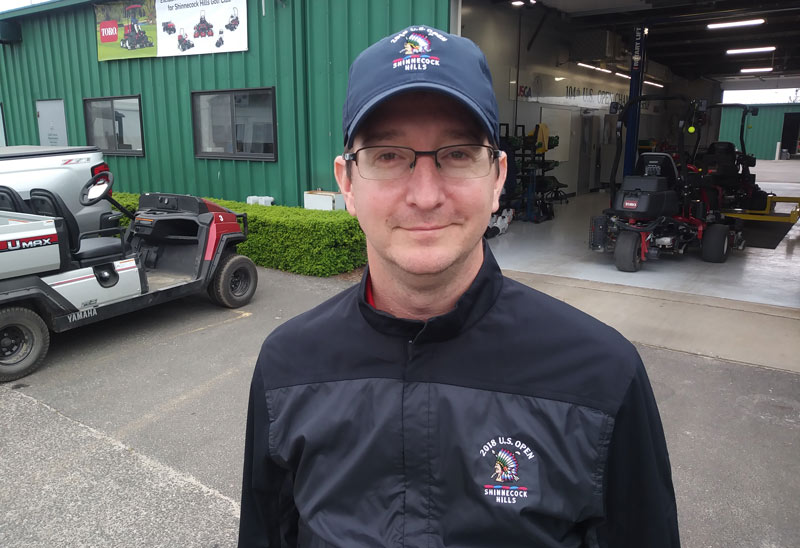
John Kaminski, Ph.D., on the scene at Shinnecock Hills Golf Club Wednesday. Photo by Howard Richman
John Kaminski, Ph.D., is an educator. He teaches. Guides. Trains.
Nobody, however, trained him on how to handle the news that you have cancer. In May, Kaminski was told by his doctor that he has testicular cancer. At age 43, Kaminski faces a future that his students at Penn State likely don’t understand and won’t be schooled on unless someone like him tells them about it. And he will.
“I’m pragmatic about things. I was like, ‘OK, I have it. What do I do about it?’ I was thinking, ‘I just want to live,’” says Kaminski, who is at Shinnecock Hills Golf Club in Southampton, N.Y., this week as a maintenance team volunteer for the U.S. Open.
An associate professor of turfgrass management and the director of the golf course turfgrass management program at Penn State University, Kaminski entered into quite an eventful 30-day span beginning in mid-May. It started when he traveled to GCSAA headquarters in Lawrence, Kan., to attend the Student Task Group meeting. By that time, Kaminski had already detected that he had a health issue. Not pain, but he’d determined something wasn’t right after feeling a lump.
He went to the doctor five days after returning from the GCSAA event. Then, the day after Memorial Day, he visited a specialist, who confirmed that he had multiple lumps. And, indeed, it was testicular cancer. The American Cancer Society estimates that there will be about 9,310 new cases of testicular cancer diagnosed this year and about 400 deaths.
Twenty-four hours later — which was just two weeks ago today — Kaminski underwent surgery.
Even that wasn’t smooth. It was scheduled to last 20 minutes, but Kaminski says it took 70 because of complications. He was diagnosed with stage 1A cancer, which means it hasn’t spread to lymph nodes or distant sites. He’s currently in the healing process and says he’s still encountering some numbness in his left leg, all of which means no heavy lifting this week. He has yet to determine whether chemotherapy or radiation will be part of his recovery. He will learn more about chemotherapy next week and about radiation July 3.
Kaminski’s spirits got a lift from his favorite hockey team, the Washington Capitals, who recently won the Stanley Cup. In fact, three days after his surgery, Kaminski attended Game 3 of the series that Washington won 3-1. “I was pretty sore, but it was worth it,” says Kaminski, a 22-year GCSAA member.
He figures it may be worthwhile to share the word about cancer with some of his students. He noted that many of them are at an age where they are focused on working hard and trying to build a career, so perhaps someone like him can help put things in perspective. “I usually talk about things like taking time for your family,” Kaminski says, “but they really need to learn to take care of themselves health-wise.”
Update: On June 19, Kaminski met with an oncologist, and his future course of action will be aggressive monitoring only. Because the cancer was detected early and surgery was able to remove it all, doctors aren’t recommending any follow-up treatments.
Howard Richman is GCM’s associate editor.